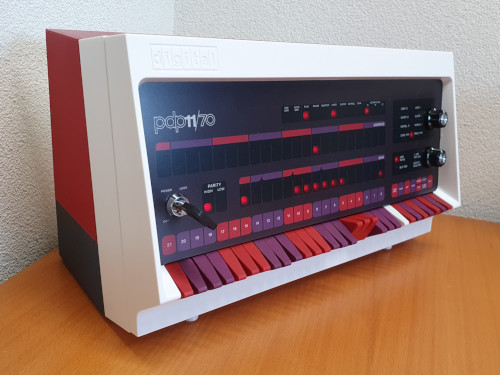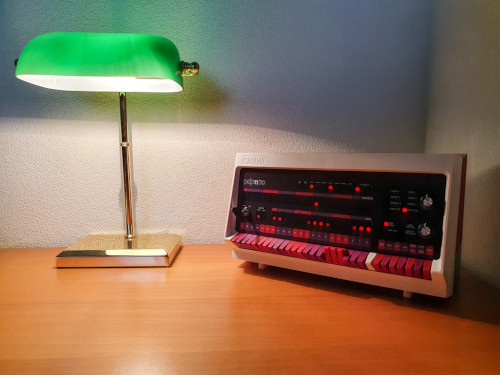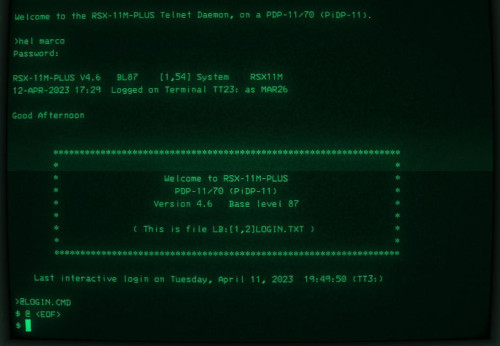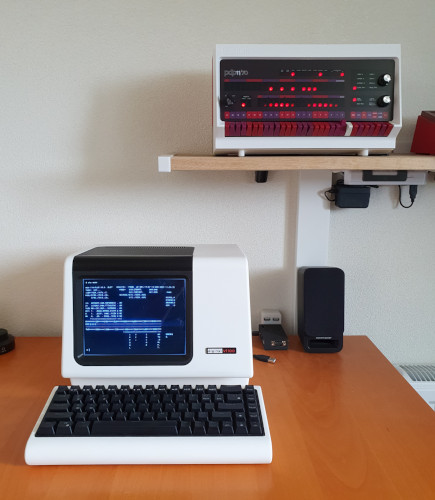

Apparently, there are over 1.1 billion websites in the world (no, I didn't count them myself), which also means there are an unbelievable amount of web servers active, even considering many will serve more than one website. Many of these use Nginx, Apache, IIS or any other flavour of web server software. To the end user it is impossible to tell which web server software they are looking at, or on which hardware platform.
Imagine a web page hosted on "ancient" hardware (unfortunately emulated, I wish I had the real deal, but then again I wouldn't know where to put it...), running a "forgotten" Operating System, from a time long before "the web", "the internet" and even networking as standard. Well...actually...you're looking at one!
This page is hosted on a DEC PDP-11/70 (actually a PiDP-11) with RSX-11M-PLUS 4.6 as its Operating System. Neat.
Hardly any markup, simple white background, only text and a few images. This is how I remember web pages looked like, right at the beginning of the World Wide Web. But even then these pages were hosted on more modern hardware, and software (Unix, mostly).
I built my PiDP-11 kit in early 2022, and it has been happily blinking its lights ever since. It is basically a Raspberry Pi 4, with SIMH and Blinkenbone, mounted in a replica of a 70's-era DEC PDP-11/70 minicomputer (not much mini about the PDP-11, but what's in a name?) frontend panel. SIMH is a multi-system emulator, allowing y ou to boot in to many old and historic software via simulation of the hardware on which it used to run. Blinkenbone adds another layer to that, connecting SIMH to the PDP-11/70 frontend panel with its many switches, LED's and rotary buttons. The end result is fantastic, and for the moment forgetting that a frontend panel is actually only a small part of a real PDP-11, and the somewhat smaller scale of the replica panel, you are forgiven for thinking it's the 70's again and you are actually working on a real PDP-11!


PiDP-11 offers a whole bunch of old operating systems which were relevant to the PDP-11, both DEC developed and third-party. It can of course also be programmed in assembler, and even in machine language using the row of toggle switches on the frontend panel. When I was still new to the PiDP-11 (and PDP-11 in general) I chose 2.11BSD as "my" operating system. This Berkely Unix flavour comes with many additional features (such as fully functional networking, a web server, etc.) and feels quite familiar straight out of the box, for people like me used to working with Linux.
Besides that, I also took a deep dive into assembler programming, ending up with an "improved" idle blinkenlight program I dubbed "ChasingLEDs", which was not only a great learning experience but also mesmerising to look at.

Recently I felt the urge "to do more with the PDP-11", maybe it was time to take a deep dive into a new world. I decided to try RSX-11M-PLUS, at least there is a brief description of it in the PiDP-11 manual. The manual warns
And that's true, the first time trying to get to
grips with RSX-11 throws you right back to the moment you first laid your hands on a working computer...any computer!RSX is different. As in, not like Unix.
It is so alien at first, but with trial and error, some reading and initially a lot of head scratching, it slowly becomes more natural until the penny drops and you actually start to like and even appreciate it. Well at least I did.
RSX-11M-PLUS does not natively support TCP/IP networking, the kind of connectivity with other computers and even the outside world we all take for granted nowadays on any kind of computer, but fortunately there were third-party hardware and software solutions for this. Even today some very smart people are still improving on the TCP/IP stack for the RSX-11M-PLUS.
The RSX-11M-PLUS disk image available for the PiDP-11 already comes with TCP/IP installed, but that's an older version which should be updated by the user. So I did, thankfully with a step-by-step guide which not only allowed me to do the update but also offered a good way in trying to understand what each and every command did. After the update I had a failure, so I restored the disk image and did the update another two times, finally finding there was a command in another file which needed to be chan ged. Another good learning experience. By the way the PiDP-11 forum was very helpful there, and is for all kind of related matters. After that I also installed the package manager (RPM), and while I was at it customised some start-up scripts and welcome messages to my likings.
The editor EDT takes time to get used to, with its different modes, and I still haven't found a way to get character delete working, despite (sort of) knowing what is going on, which might even be impossible with my setup. That is a nuisance...but I can work around it well enough.
I'm still learning, still feel like a novice, but by now I know my way around. And, to my own initial surprise, I like it!

Having a PiDP-11 on the shelf happily blinking its lights is one thing, putting it to use is another. Now, it can hardly compare to any modern system, I can for instance do countless more stuff on my mobile phone than on any retro computer, but that is not its point, nor its reason of existence.
One fun thing to do is to have it actually host a web page, or even a web site, going back to the roots of "the internet". I'm certainly not the first hobbyist to do that, or the only one. So instead of writing down my RSX-11 experiences on the forum, or on a blog page, I thought I might just as well put it on the PiDP-11 itself. That way, when it is available to the outside world (my PiDP-11 is always on, but not necessarily always running RSX-11) it is actually doing something useful. Win-win. You ge t to read this, I get to see nice blinkenlights.
Thanks to FTP now configured on the RSX-11 it has become easy to edit and upload content, taking me back to my early forays into website building when FTP was the only way to do stuff on a remote web server.
You might have noticed that it is all https, which might seem odd as the RSX-11 has no concept of SSL, encryption and certificates (I'm assuming?), but that is taken care off by my reverse proxy which also acts as the encryption endpoint.
I am just a hobbyist who likes tinkering with all kinds of retro computers and electronics, eager to learn new things and skills. In no way would I be able to design and market something amazing like the PiDP-11, or bring old forgotten software into the 21st century. Respect to those who can, and do!
Marco Dirkx
April 2023